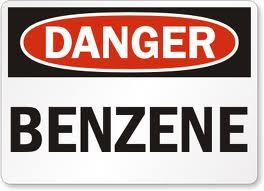Benzene Cancer Lawsuit Lawyer

The Dr Shezad Malik Law Firm helps injured workers who develop Benzene cancer get the recovery they need after being exposed to Benzene, the highly toxic industrial solvent.
Benzene is an aromatic hydrocarbon that is a component of products derived from coal and petroleum and is found in gasoline and other fuels.
Workers employed in benzene industries include benzene production (petrochemicals, petroleum refining, and coke and coal chemical manufacturing), rubber tire manufacturing, storage or transport of benzene and petroleum products containing benzene, are at high risk of benzene exposure. Other workers who may be exposed to benzene because of their occupations include steel workers, printers, rubber workers, shoe makers, laboratory technicians, firefighters, and gas station employees.
What is Benzene?
Benzene is a colorless, flammable liquid, it evaporates quickly when exposed to air. Benzene is among the 20 most widely used chemicals in the United States. It is used mainly as a solvent (a substance that can dissolve or extract other substances) and as a starting material in making other chemicals. Benzene is also a natural part of crude oil, gasoline, and cigarette smoke.
How does Benzene Exposure Occur?
The exposure to benzene occurs by inhaling benzene contaminated air. Benzene can also be absorbed through the skin during contact with a source such as gasoline, but because liquid benzene evaporates quickly, skin absorption is less common. People can be exposed to benzene at work, in the general environment, and through the use of some consumer products.
Benzene Workplace Exposures
The major source of benzene exposure occurs in the work place and in manufacturing industries that utilize benzene or make benzene. Workers in industries that make or use benzene may be exposed to high levels of this chemical. These benzene exposure industries include the rubber industry especially rubber tires, oil refineries, petroleum processing companies, chemical plants, shoe manufacturers, and petroleum-related industries. Benzene is also used in the production of some types of lubricants, dyes, detergents, drugs, and pesticides.
Other workers who may be exposed to benzene at work include steel workers, printers, lab technicians, and firefighters.
Benzene Community Exposures
There are many sources of benzene in the environment include gasoline, automobile exhaust fumes, emissions from some petroleum processing factories, and waste water from certain benzene utilizing companies and especially in the tanning industries.
Exposures can be substantial to people in enclosed spaces with unventilated fumes from gasoline, glues, lacquer, paint thinners, solvents, paints, and art supplies. Areas of heavy traffic, motor ways, gas stations, gas pumping stations, chemical plants, and areas near industrial sources may also have higher air levels.
Gasoline and cigarette smoke are two main sources of human exposure to benzene . Benzene exposure can be reduced by limiting contact with these sources . People are exposed to benzene from both active and passive second-hand smoke. Average smokers take in about 10 times more benzene than nonsmokers each day.
Cigarette smoking and secondhand smoke are important sources of exposure to benzene. Cigarette smoke accounts for more than half of the US national exposure to benzene. Benzene levels in rooms contaminated by tobacco smoke may be many times higher than normal unsmoked in room.
How does Benzene Cause Cancer?
Benzene is known to cause cancer, based on evidence from studies in both people and laboratory animals. The link between benzene and cancer has largely focused on leukemia and cancers of other blood cells.
Benzene Cancer Medical Studies
Rates of leukemia, particularly acute myeloid leukemia (AML), have been found to be higher in studies of workers exposed to high levels of benzene, such as those in the chemical, shoe making, and oil refining industries.
Some studies have also suggested links to acute lymphocytic leukemia (ALL) in children and to chronic lymphocytic leukemia (CLL) and other blood-related cancers, such as multiple myeloma and non-Hodgkin lymphoma, in adults.
The International Agency for Research on Cancer (IARC) is part of the World Health Organization (WHO). The IARC major goal is to identify causes of cancer. IARC classifies benzene as a “known human carcinogen”, with “sufficient” evidence that benzene causes acute myeloid leukemia (AML).
The National Toxicology Program (NTP) is formed from parts of several different US government agencies, including the National Institutes of Health (NIH), the Centers for Disease Control and Prevention (CDC), and the Food and Drug Administration (FDA). The NTP has classified benzene as “known to be a human carcinogen”.
The US Environmental Protection Agency (EPA) maintains the Integrated Risk Information System (IRIS), an electronic database that contains information on human health effects from exposure to various substances in the environment. The EPA classifies benzene as a known human carcinogen.
Does Benzene Exposure Cause any Other Health Problems?
Benzene is a potentially dangerous chemical. High levels of exposure can cause both short-term and long-term health effects.
Short-Term Effects
Breathing in high doses of benzene may affect the central nervous system, which can lead to drowsiness, dizziness, headaches, tremors, confusion, and/or unconsciousness.
Consuming foods or fluids contaminated with high levels of benzene can cause vomiting, dizziness, sleepiness, convulsions, and rapid heart rate. In extreme cases, death may occur after inhaling or swallowing very high levels of benzene. Exposure to benzene liquid or vapor may irritate the skin, eyes, and throat. Skin exposure to benzene may result in redness and blisters.
Long-Term Effects
Long-term exposure to benzene harms the bone marrow, the soft, inner parts of bones where new blood cells are made. This results in:
Anemia (a low red blood cell count), which can cause a person to feel weak and tired. A low white blood cell count, which can lower the body’s ability to fight infections and may even be life-threatening. A low blood platelet count, which can lead to excessive bleeding.
Several government agencies regulate benzene levels and exposures. The Occupational Safety & Health Administration (OSHA), the federal agency responsible for health and safety regulations in most workplaces, limits workplace exposure to benzene in the air to 1 ppm (part per million) during an average workday and a maximum of 5 ppm over any 15-minute period.
When working at potentially higher exposure levels, OSHA requires employers to provide personal protective equipment such as respirators.
The EPA limited the percentage of benzene allowed in gasoline and as of 2011, this limit is reduced to an average of 0.62% (with a maximum of 1.3%). The EPA limits concentrations of benzene in drinking water to 5 ppb (parts per billion). The US Food and Drug Administration (FDA) set a limit of 5 ppb in bottled water.
How to Limit Exposure to Benzene?
- If you are concerned about Benzene, there are several ways you can limit your exposure. If needed, the Occupational Safety & Health Administration (OSHA) can provide more information or make an inspection.
- Stay away from cigarette smoke. If you are a smoker, try to quit. Cigarette smoke is a major source of benzene exposure.
- Try to limit gasoline fumes by pumping gas carefully and choosing gas stations with vapor recovery systems that capture the fumes. Avoid skin contact with gasoline.
- Use common sense around any chemicals that might contain benzene. Minimize or avoid exposure to fumes from solvents, paints, and art supplies, especially in unventilated spaces.
- For short-term exposure to high levels of benzene, the Centers for Disease Control and Prevention (CDC) recommends getting away from the source of benzene, removing any clothing that may have benzene on it, washing exposed areas with soap and water, and getting medical care as soon as possible.
If you think you may have been exposed to benzene over a long period of time, speak to a doctor. Benzene can be measured in the blood or breath, and breakdown products of benzene can be measured in the urine. These tests can only detect recent exposures to benzene. They cannot predict possible health effects.
Information and commentary provided by Dallas Fort Worth Personal Injury Attorney Dr Shezad Malik. The Dr Shezad Malik Law Firm can be contacted in Dallas toll free at 214-390-3189. If you or a loved one has been injured from Benzene exposure, or developed Benzene cancer please fill out our contact card for a free consultation.


